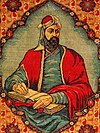
Back Nezami Afrikaans نظامي الكنجوي Arabic نظامى الكنجوى ARZ Nezamí Ganyaví AST Nizami Gəncəvi Azerbaijani نظامی گنجوی AZB Низами Гәнжәүи Bashkir Нізамі Гянджэві Byelorussian Низами Ганджеви Bulgarian Nizami Gandjawi Catalan
Nizami Ganjavi | |
|---|---|
 Rug depiction of Nizami Ganjavi (1939), Ganja Museum, Republic of Azerbaijan | |
| Born | c. 1141 (earlier date c. 1130 has also been suggested) Ganja, Seljuk Empire (modern-day Republic of Azerbaijan) |
| Died | 1209 (aged 68–78) Ganja (Shirvanshah dynasty, modern-day Republic of Azerbaijan) |
| Period | 12th century |
| Genre | Romantic Persian epic poetry,[1] Persian lyrical poetry, wisdom literature |
| Notable works | Khamsa or Panj Ganj ('Five Treasures') |
This article contains too many or overly lengthy quotations. (January 2025) |
 |
| Part of a series on |
| Nizami Ganjavi |
|---|
| The Khamsa or Panj Ganj |
| Related topics |
| Monuments |
|
Nizami Mausoleum • Nizami Museum of Azerbaijani Literature • Nizami Gəncəvi (Baku Metro) • in Ganja • in Baku • in Beijing • in Chișinău • in Rome • in Saint Petersburg • in Tashkent |
Nizami Ganjavi (Persian: نظامی گنجوی, romanized: Niẓāmī Ganjavī, lit. 'Niẓāmī of Ganja'; c. 1141 – 1209), Nizami Ganje'i,[2] Nizami,[3] or Nezāmi, whose formal name was Jamal ad-Dīn Abū Muḥammad Ilyās ibn-Yūsuf ibn-Zakkī,[4] was a 12th-century Muslim poet. Nizami is considered the greatest romantic epic poet in Persian literature,[5] who brought a colloquial and realistic style to the Persian epic.[1][3] His heritage is widely appreciated in Afghanistan,[2] Republic of Azerbaijan,[6] Iran,[2] the Kurdistan region[7][8][9] and Tajikistan.[2]
- ^ a b "Neẓāmī". Encyclopædia Britannica Online. Encyclopædia Britannica. 2009. Archived from the original on December 4, 2008. Retrieved February 28, 2009.
Greatest romantic epic poet in Persian Literature, who brought a colloquial and realistic style to the Persian epic. [...] Nezami is admired in Persian-speaking lands for his originality and clarity of style, though his love of language for its own sake and of philosophical and scientific learning makes his work difficult for the average reader.
- ^ a b c d Cite error: The named reference
FrancoisePersianLiteraturewas invoked but never defined (see the help page). - ^ a b Meisami, Julie Scott (1995). The Haft Paykar: A Medieval Persian Romance. Oxford University Press.
Abû Muhammad Ilyas ibn Yusuf ibn Zaki Mu'ayyad, known by his pen-name of Nizami, was born around 1141 in Ganja, the capital of Arran in Transcaucasian Azerbaijan, where he remained until his death in about 1209. His father, who had migrated to Ganja from Qom in north central Iran, may have been a civil servant; his mother was a daughter of a Kurdish chieftain; having lost both parents early in his life, Nizami was brought up by an uncle. He was married three times, and in his poems laments the death of each of his wives, as well as proffering advice to his son Muhammad. He lived in an age of both political instability and intense intellectual activity, which his poems reflect; but little is known about his life, his relations with his patrons, or the precise dates of his works, as the accounts of later biographers are colored by the many legends built up around the poet
- ^ Mo'in, Muhammad(2006), "Tahlil-i Haft Paykar-i Nezami", Tehran.: p. 2: Some commentators have mentioned his name as “Ilyas the son of Yusuf the son of Zakki the son of Mua’yyad” while others have mentioned that Mu’ayyad is a title for Zakki. Mohammad Moin, rejects the first interpretation claiming that if it were to mean 'Zakki son of Muayyad' it should have been read as 'Zakki i Muayyad' where izafe (-i-) shows the son-parent relationship but here it is 'Zakki Muayyad' and Zakki ends in silence/stop and there is no izafe (-i-). Some may argue that izafe is dropped due to meter constraints but dropping parenthood izafe is very strange and rare. So it is possible that Muayyad was a sobriquet for Zaki or part of his name (like Muayyad al-Din Zaki). This is supported by the fact that later biographers also state Yusuf was the son of Mu’ayyad
- ^ Cite error: The named reference
IranicaClassicalwas invoked but never defined (see the help page). - ^ Cite error: The named reference
Rypkawas invoked but never defined (see the help page). - ^ Vladimir Minorsky. Studies in Caucasian History. Retrieved 2014-03-23.
- ^ Thomas de Waal. The Caucasus: An Introduction. Retrieved 2014-03-23.
- ^ "Nizami Ganjavi - USSR Politicization - Iranian Persian Civilization - Nezami Ganjei". Azargoshnasp.net. Archived from the original on 2012-07-07. Retrieved 2014-03-23.